Two Weeks’ Notice Resignation Letter Samples
-
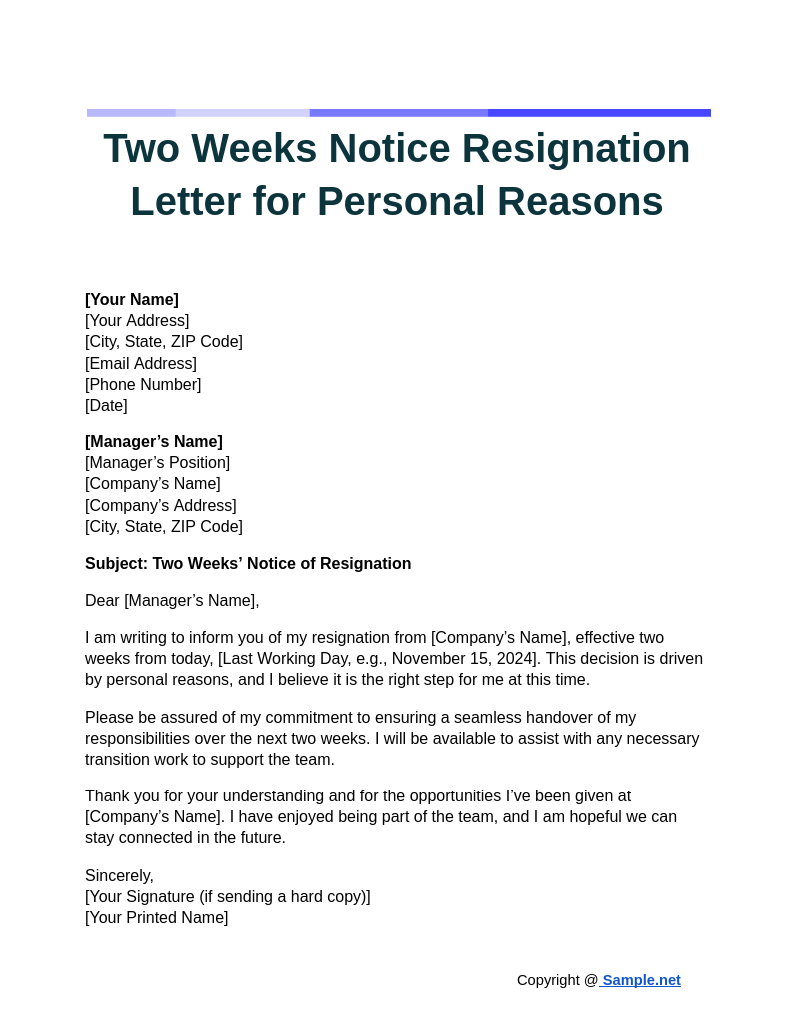
Two Weeks Notice Resignation Letter for Personal Reasons
download now -
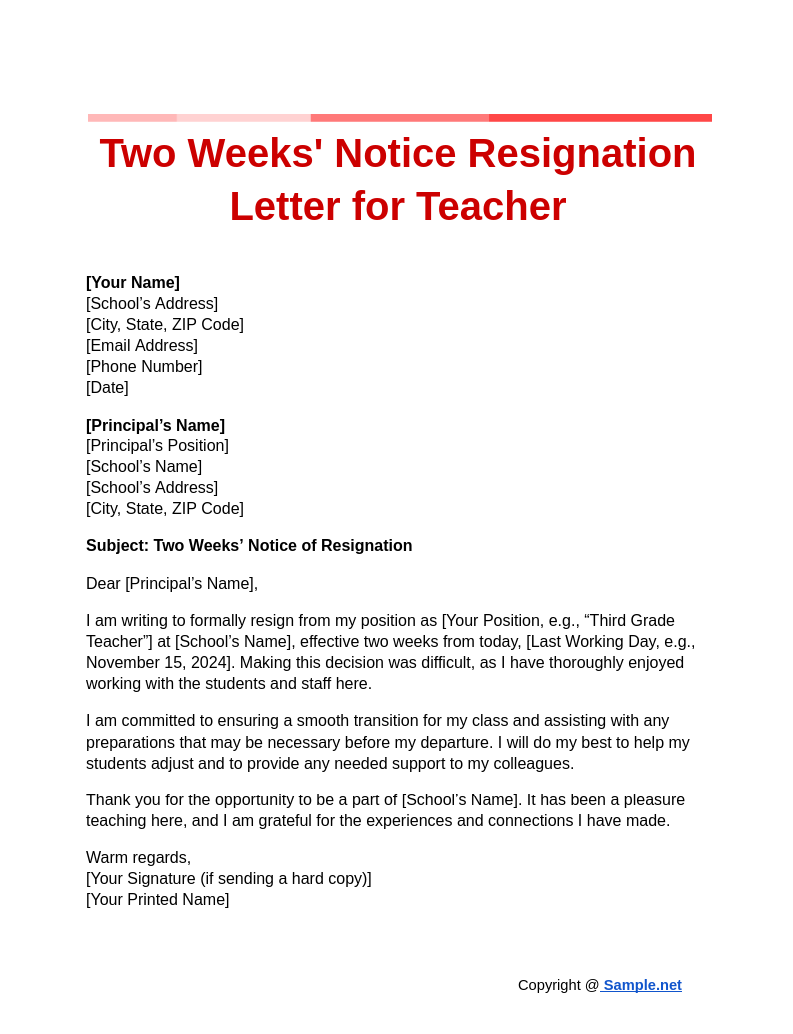
Two Weeks’ Notice Resignation Letter for Teacher
download now -
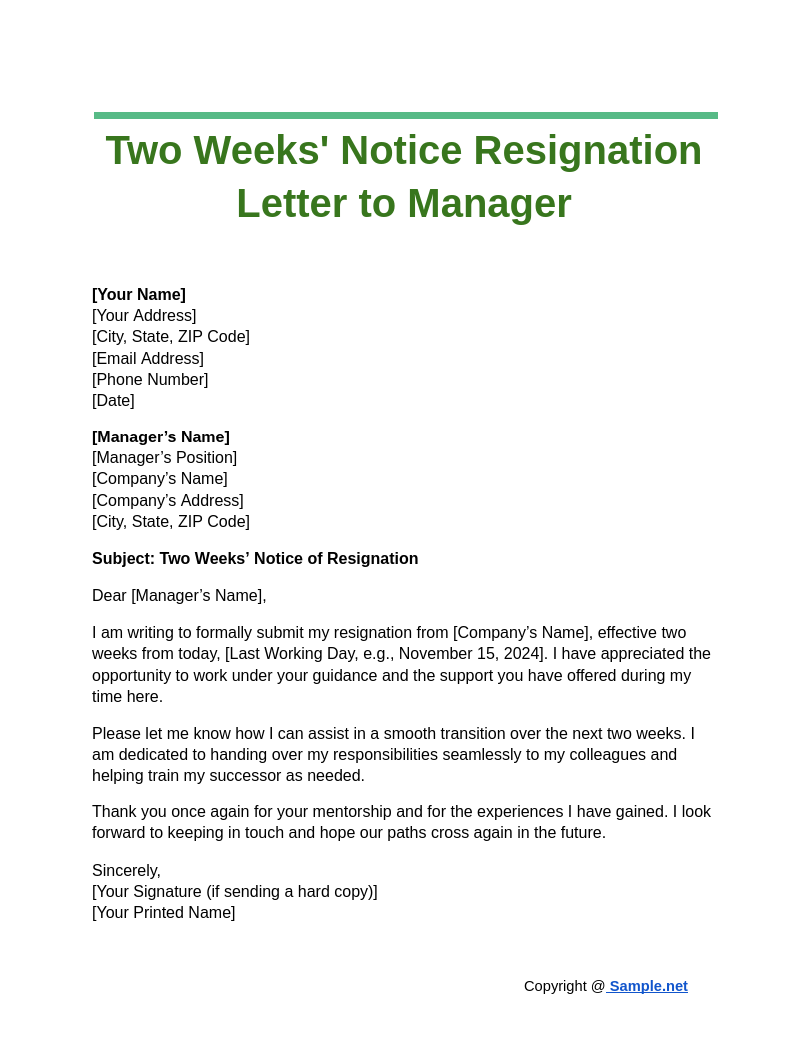
Two Weeks’ Notice Resignation Letter to Manager
download now -

Two Weeks Notice Resignation Letter with Immediate Effect
download now -
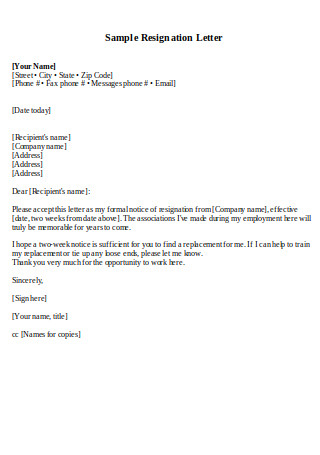
Sample Two Week’s Resignation Letter
download now -
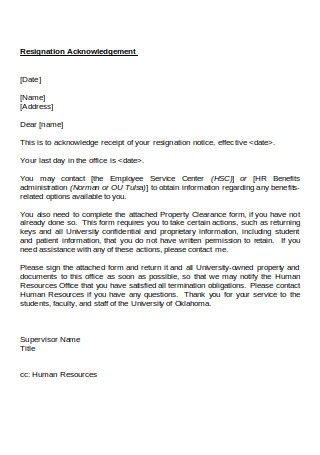
Resignation Acknowledge Letter
-
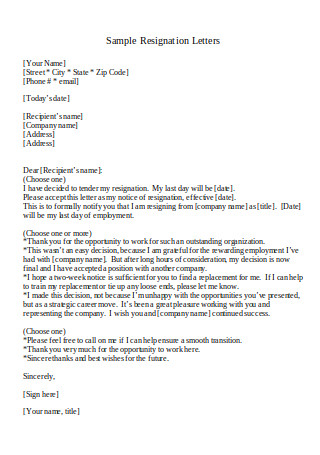
Resignation Acknowledge Letter
-
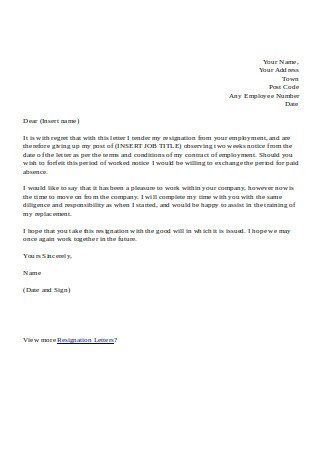
Formal Resignation Letter with 2 Weeks Notice
-

Two Weeks Notice Letter
-
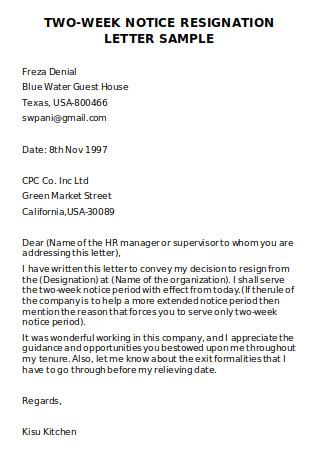
Two-Week Notice Resignation Letter Sample
-
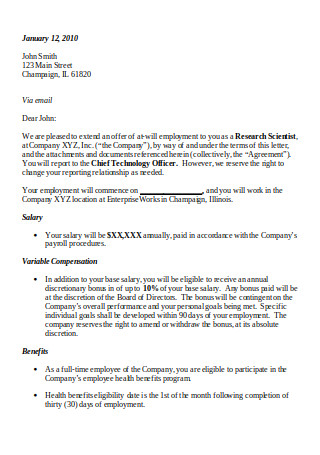
Employment Offer Letter
-
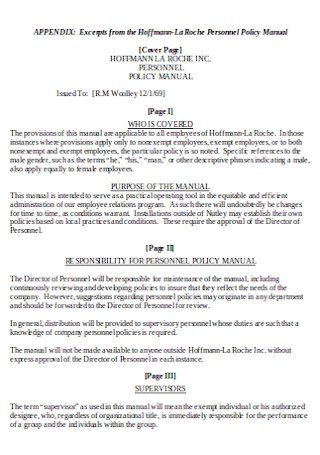
Two Weeks Notice of Resignation
-
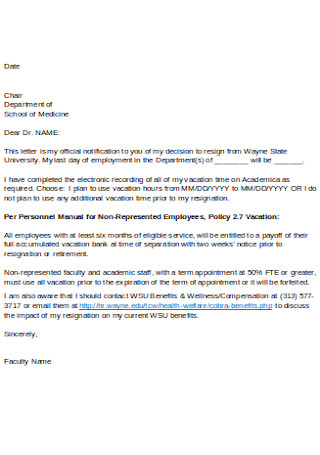
Resignation Letter of Two Weeks Notice
-
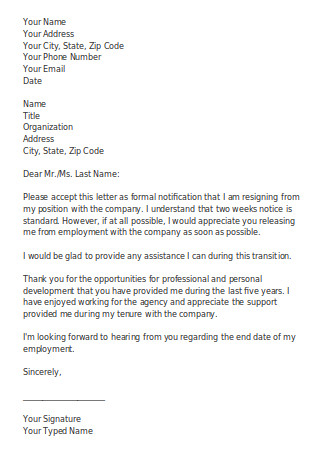
2-Weeks-Notice Resignation Letter
-
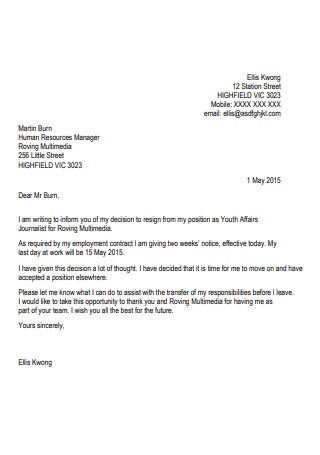
Sample Resignation Notice Letter
-
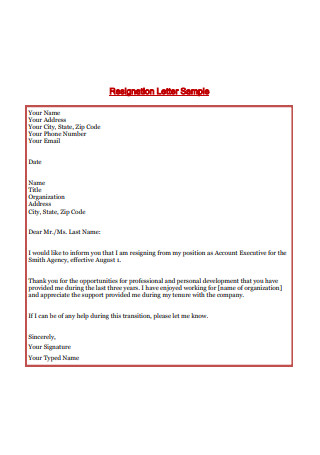
Simple 2-Weeks-Notice Resignation Letter
-
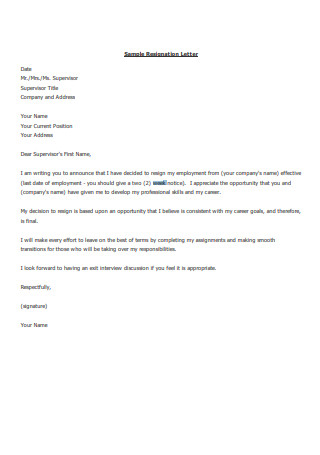
Two Weeks’ Notice Resignation Letter
-
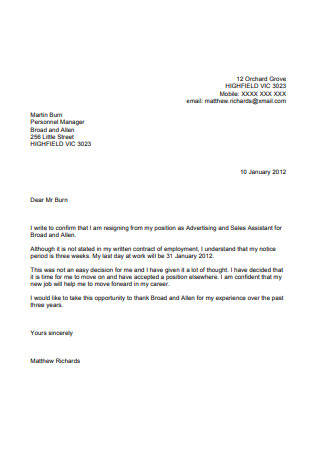
Sample Two Weeks’ Notice Resignation Letter
-
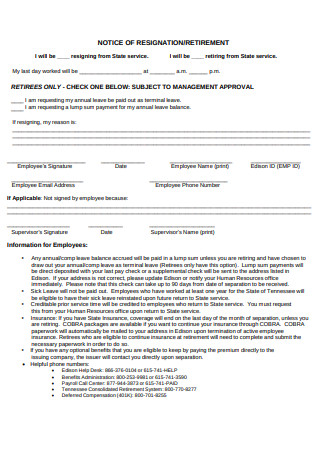
Notice of Resignation Retirement Letter
-
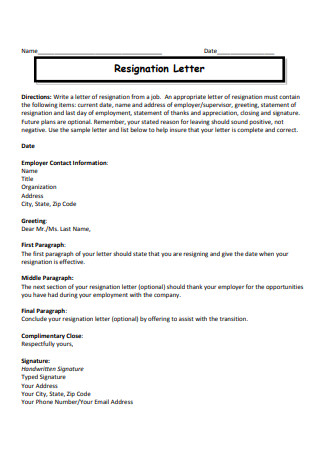
Printable 2 Weeks’ Notice Resignation Letter
-
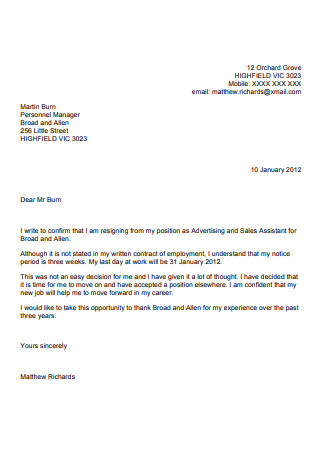
Two Weeks Resignation Notice
-

Printable Two Weeks Resignation Letter
-
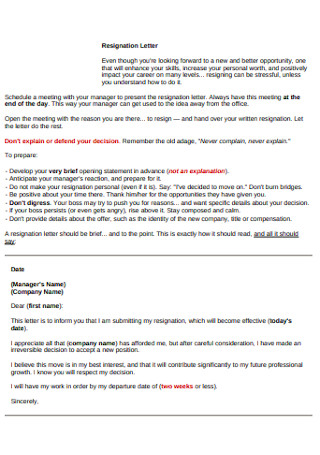
Sample Resignation Letter Format
-
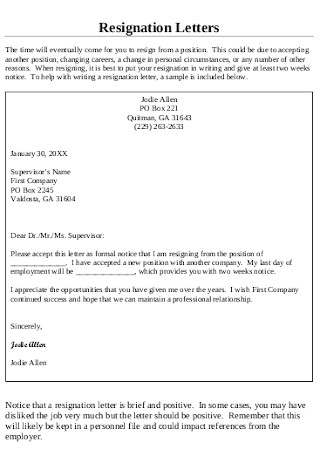
Resignation Letter Format in PDF
-
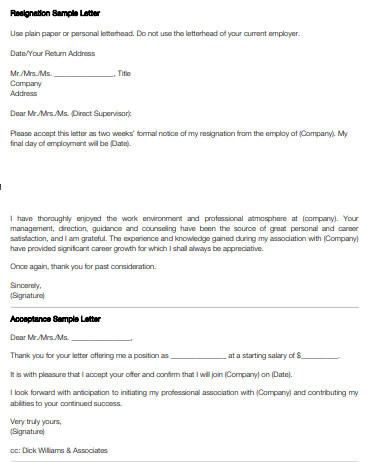
Resignation and Acceptance Sample Letters
FREE Two Weeks Notice Resignation Letter s to Download
Two Weeks’ Notice Resignation Letter Format
Two Weeks’ Notice Resignation Letter Samples
What is a Two Weeks’ Notice Resignation Letter?
How to Write a Two Weeks’ Notice Resignation Letter
Two Weeks’ Notice Resignation Letter vs. Two Weeks’ Notice Resignation Email
FAQS
Why should I give two weeks’ notice?
What should I include in the resignation letter?
What if my employer asks me to leave before the two-week period ends?
What are the risks of not providing two weeks’ notice?
How can I make my resignation letter leave a positive impact?
Can I email my Two Weeks’ Notice Resignation Letter?
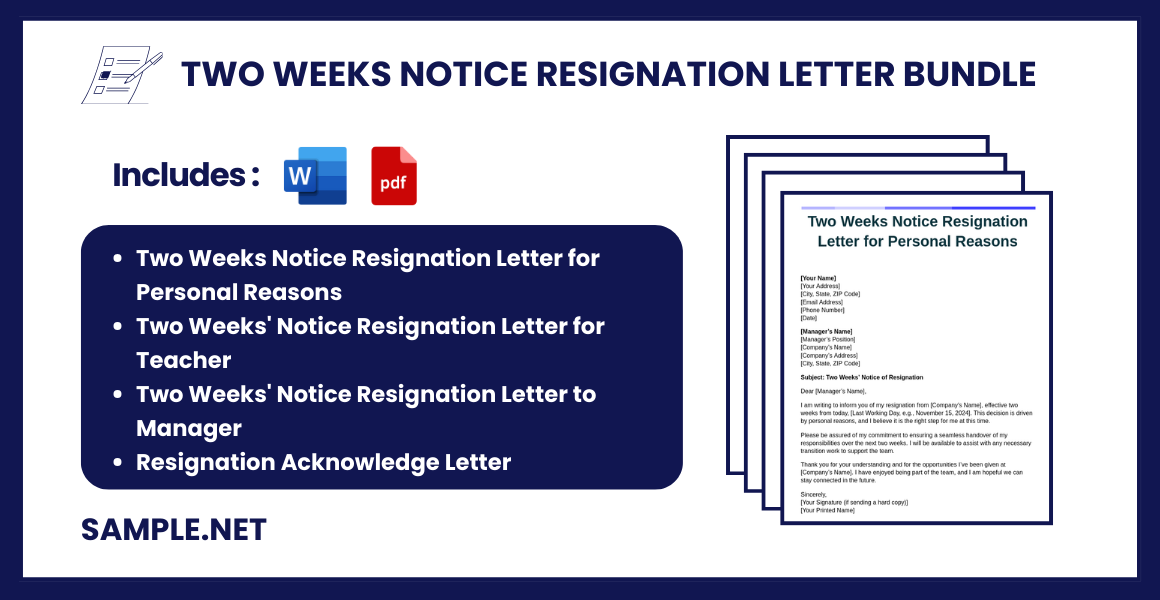
Download Two Weeks Notice Resignation Letter Bundle
Two Weeks’ Notice Resignation Letter Format
[Your Name]
[Your Address]
[City, State, ZIP Code]
[Email Address]
[Phone Number]
[Date]
[Recipient’s Name]
[Recipient’s Position]
[Company’s Name]
[Company’s Address]
[City, State, ZIP Code]
Subject: Two Weeks’ Notice of Resignation
Dear [Recipient’s Name],
I am writing to formally announce my resignation from [Company’s Name], effective two weeks from today, [Last Working Day, e.g., November 15, 2024]. This decision was not easy, and it comes after careful consideration of my current role and future career goals.
I am incredibly grateful for the opportunities and support I have received during my time at [Company’s Name]. Working with such a dedicated team has been a truly enriching experience, and I am honored to have contributed to our projects and goals.
Over the next two weeks, I am committed to ensuring a smooth transition. I am happy to assist in training my replacement, delegating my duties, and providing any additional support as needed.
Thank you once again for the opportunity to be part of [Company’s Name]. I look forward to staying in touch, and I hope to cross paths again in the future.
Sincerely,
[Your Signature (if sending a hard copy)]
[Your Printed Name]
What is a Two Weeks’ Notice Resignation Letter?
A two weeks’ notice resignation letter is a formal proclamation of your intention to leave the company two weeks from the day you submit it to your department head and/or HR manager. It is the standard time frame that employees are required to render to pave the way for their departure. Although it is not a legal requirement to provide two weeks’ notice before quitting, it does give the company enough time to find a replacement and administer a smooth turnover. It is also possible for the employment contract to include a procedure regarding the contract’s termination. If the contract requires two weeks’ notice, then employees are obliged to comply with these terms upon their separation. Otherwise, they may be penalized for their actions.
“3.5 million Americans voluntary leave their job each month since January 2019.” (Source: Bureau of Labor Statistics)
“38% of workers want to leave their jobs due to a toxic work culture or one where they don’t feel they fit in.” (Source: Randstad)

How to Write a Two Weeks’ Notice Resignation Letter
There are a ton of reasons why people choose to leave their current positions. Whether it has something to do with the company’s culture, management, or employee compensation, one’s departure is usually drawn by the desire to seek better opportunities elsewhere. But before you can finally bid goodbye to your employer, it’s important to announce your exit from the organization through a formal letter. Fortunately, writing a two weeks’ notice resignation letter is pretty easy with the help of the following steps.
Step 1: Create a Letterhead
You’ve probably been learning about letter writing since elementary school. Since we now know a thing or two about the heading, body, and closing of a letter, it’s time we dig deeper into the first part of the letter: the header.
The header should comprise of you and your recipient’s contact information. This includes each party’s name, job title, business name, and office address. The contact details of the sender and the recipient of the letter must be separated by the date when the letter was written or sent to the recipient. All these are typically located on the upper-left corner of the page in block format. A formal greeting or salutation containing the recipient’s name must then follow.
Step 2: Include the Body of the Letter
The body of a resignation letter is typically kept brief and to the point. It doesn’t matter how short your paragraphs are, as long as it communicates your message clearly to the reader. The letter immediately starts with your intention to resign along with your reason for leaving. Showing positive feelings toward your work experience is also acceptable. It’s common courtesy to write a letter that is sincere and polite. Therefore, it is in every employee’s best interest to exclude issues or personal disputes that they have toward the company and its workers. Leaving the company on a sour note can paint you in a bad image, so you might want to save any feelings of resentment to yourself. You can also see more on Two Weeks Notice.
Step 3: End and Sign the Letter
Once you have finished delivering your message, you can express your thanks or well wishes in the last few lines. The final part of the resignation letter may end with a simple sign-off or closing, as well as your signature above your printed name. The great thing about a proper closing is that it demonstrates sincerity in your resignation. It also indicates that the reader has reached the end of the letter and that nothing follows. There are several options for a complimentary close, including “Sincerely,” “Best Regards,” and “Respectfully Yours,” among others. You are free to choose a closing based on your personal preference. Finally, make sure the document is signed in black or blue ink to maintain formality.
Step 4: Deliver the Letter
While this may not be a part of the actual writing process, it does play a role in ensuring your message reaches the right person. It can be delivered through snail mail, email, or in person. If you are working directly with your manager on a daily basis, you can set up a meeting to discuss matters privately. It’s never a smart idea to wait for your manager to leave so you could place the letter on his or her desk as if it doesn’t contain anything valuable. The letter could either get lost in a pile of papers or get thrown out by your manager’s secretary. Instead, it is wise to converse verbally while handing in the letter to clarify your intentions and express your sincerity over the decision. Either way, your manager would want to have a word with you in regard to your resignation. You can also see more on Official Resignation Letter.
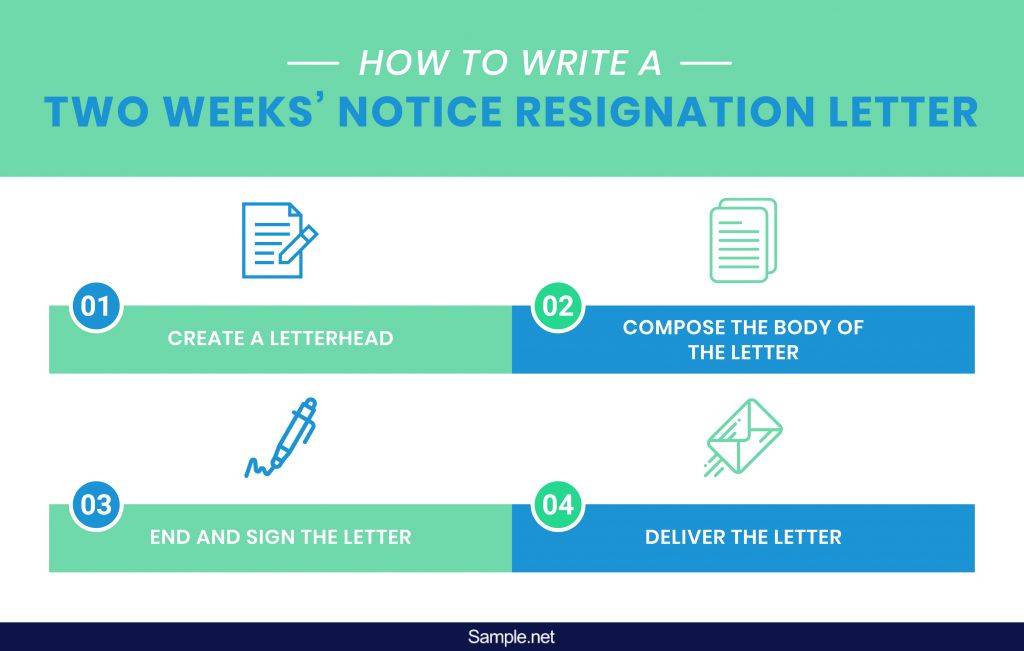
Two Weeks’ Notice Resignation Letter vs. Two Weeks’ Notice Resignation Email
The difference between a two weeks’ notice resignation letter and a two weeks’ notice email resignation letter is quite simple. For one, emails are something you send using a computer, while letters are handwritten or typewritten and printed for submission. Choosing what type of tool to use for your resignation would depend on the kind of work you do. Freelance workers who rely on the Internet to communicate with their boss are obliged to notify their employer of their resignation through email. Although sending your resignation via email might seem a bit informal, it’s the only possible means of communication for this field of work. It is also possible for the email to contain a digital version of the letter to maintain its structure. As for office-based employees, it’s only appropriate to hand over your two weeks’ notice resignation letter in person. The letter must be printed and signed prior to being submitted so that the management can keep a physical record of your resignation for future purposes. When choosing which method to use, make sure it’s appropriate for your situation.

A well-written Two Weeks’ Notice Resignation Letter demonstrates your professionalism and respect for the company. By giving ample time for a smooth transition, you uphold your reputation, allowing both you and your employer to part on positive terms. This careful step supports your future career journey and networking opportunities. You can also see more on Standard Job Resignation Letter.
FAQS
Why should I give two weeks’ notice?
Two weeks’ notice is a professional courtesy that gives your employer time to plan for your departure, transition your tasks, and ensure continuity in the team’s workflow. You can also see more on Employee Resignation Letter.
What should I include in the resignation letter?
Include your intention to resign, your last working day, expressions of gratitude, and an offer to assist with the transition to ensure a positive parting.
What if my employer asks me to leave before the two-week period ends?
Some employers may request immediate departure upon receiving your resignation. In this case, the employer may not honor the two-week notice, depending on the company policy and position. You can also see more on Immediate Letter of Resignation.
What are the risks of not providing two weeks’ notice?
Failing to give notice can harm your professional reputation, damage relations with the employer, and might limit future opportunities for references, especially if the company values notice periods.
How can I make my resignation letter leave a positive impact?
Expressing gratitude, offering to assist in the transition, and highlighting positive experiences from your role can leave a lasting positive impression, making the resignation constructive for both you and your employer.
Can I email my Two Weeks’ Notice Resignation Letter?
Yes, if appropriate in your workplace, emailing a resignation letter is acceptable. However, meeting in person or discussing it before sending the email can add a personal touch.
